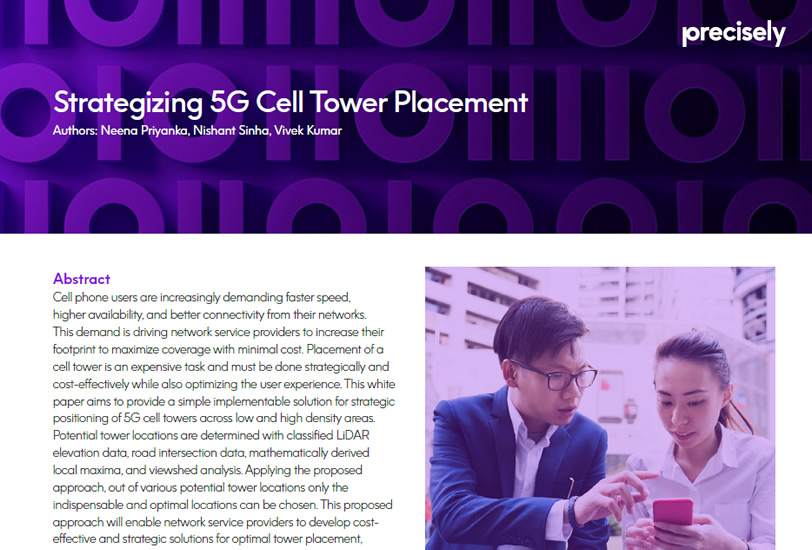White Paper
Strategizing 5G Cell Tower Placement
5G cell towers needed to maximize coverage with minimal cost and meet customer demand
Cell phone users are increasingly demanding faster speed, higher availability, and better connectivity from their networks. This demand is driving network service providers to increase their footprint to maximize coverage with minimal cost. Placement of a 5G network cell tower is an expensive task and must be done strategically and cost-effectively while also optimizing the user experience. This white paper aims to provide a simple implementable solution for strategic positioning of 5G cell towers across low and high density areas. Potential tower locations are determined with classified LiDAR elevation data, road intersection data, mathematically derived local maxima, and viewshed analysis. Applying the proposed approach, out of various potential tower locations only the indispensable and optimal locations can be chosen. This proposed approach will enable network service providers to develop cost-effective and strategic solutions for optimal tower placement, maximizing their profit.
The needs of the increasing mobile consumer base are changing. Today’s mobile users expect high data speed, low network latency, greater stability, and the ability to connect more devices. In 2020, the number of mobile users worldwide is forecasted to grow to 7.26 billion (Figure 1). Additionally, the total installed base of Internet of Things (IoT) connected devices is projected to reach 75.44 billion worldwide by 2025, which is a five-times increase over ten years. This traffic is expected to grow multifold particularly in urban centers, as 4G networks will be insufficient to meet consumer requirements. Consumer demands are paving the way for 5G networks – the fifth generation of cellular network technology. Below is a quick glimpse at how telecommunications and wireless technology have developed thus far, and how the different generations differ from each other.
5G networks promise to deliver faster data speeds, greater connectivity, increased reliability, and higher bandwidth as service areas covered by providers will be divided into small geographical areas called cells. This will also boost the development of other new technologies such as Internet of Things (IoTs), autonomous vehicles (AVs), augmented reality (AR) and virtual reality (VR).
Read this whitepaper and learn more about how network service providers need to increase 5G cell tower placement to maximize coverage with minimal cost while at the same time meeting customer demand.
